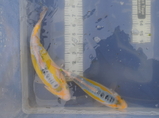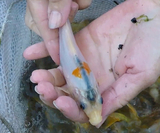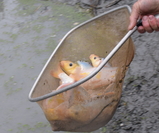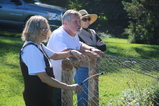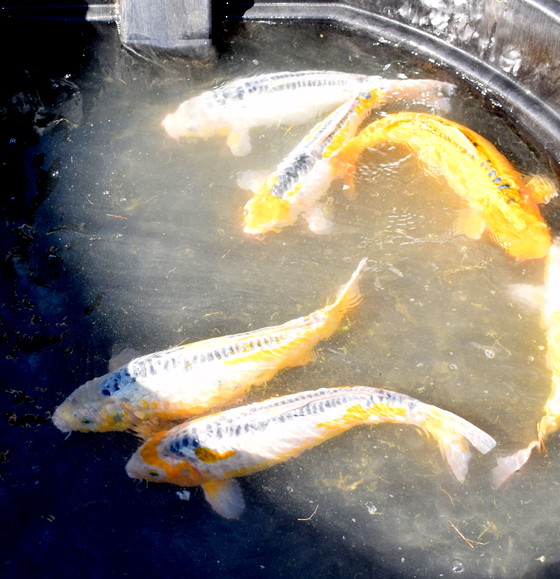FAQ
I select the keepers, the koi that have the traits I’m looking for in the offspring. First, I don’t keep potential parent fish who have deformities. I look for good conformation, then I look for fish with good markings. I eliminate those who are fully scaled from my breeding pond because shusui is doitsu, that is leather-skinned. A fish that only has the double row of blue scales along the dorsal ridge, a few clear scales near the gills are okay.
John Clark, owner of Northeastern Aquatics Fish Hatcheries in Rhinebeck, New York, takes the Koi I will not use for breeding and sells them to people who wish to add them to their backyard or farm ponds.
The ki shusui is a yellow shusui. Shusui is a koi with red markings coming from the belly of the fish up both sides in bands towards the dorsal ridge. In really good shusui, the red bands are symmetrical. It is a beautiful variety but I had heard and seen pictures of ki shusui, a yellow version of shusui. However there was little to no information on how to breed a red fish and get yellow offspring.
I used the little information, often speculation on how to breed ki shusui. I was fortunate in discovering types of midori – a green scaleless koi with a standard shusui and in the first hatch, I found several individuals with the traits I was looking for.
This was a big happy day for me and my friends who were hoping that this desirable outcome was achieved in such a short time.
Yes, I can tell. Even when the ponds are muddy. The markings differ slightly and I find that each ki shusui is unique.
It is said that koi live for two hundred years in Japan and two weeks in New York.
This is a joke that highlights the truth. In Japan, the koi and offspring are often passed by breeders to a younger generation when the older generation is ready to retire. If a breeders family continues to breed the variety they have cultivated, their chances of long living koi would naturally result because how to raise and care for the fish is also passed down.
Not so, in New York (an example) where the buyer of the koi is having a first time and usually a first generational experience with koi. Mistakes in caring for the fish are common, but can be learned. But not as an FAQ.
Koi usually breed in the spring. The koi breeder will notice spawning activity in the surrounding reeds or grasses. No poetry, alcohol, or promises are exchanged.
Shusui (pronounced shoo-swee) means autumn sunset for the red markings on the white or pale blue base color of the skin.
This is where experience, a tried-and-true bred line of parents comes in. Because koi, or ornamental carp, have been popular in countries around the world, each culture breeding the koi to achieve specific desirable traits, results in some koi having scales, some without, some have long fins, or pearlescent skins, and sometimes wild carp get into the mix. In other words, most koi have a random mix of numerous traits.
The only way to tell what fish is carrying which genetic traits is by assessing what the koi looks like, which genes are expressed, rather than looking at DNA through a microscope and matching the individuals based on how close they are to the desired outcome – genotype.
Backyard breeders like me, choose koi by what it looks like.
